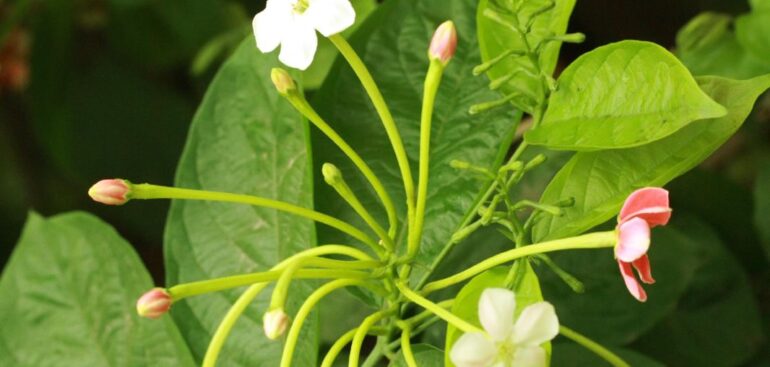
Wormwood – Quisqualis indica L. – Author Pham Ha Thanh Tung
Nam Xuan Lac Species and Habitat Conservation Area was approved by the People’s Committee of Bac Kan province in Decision No. 342/QD-UB dated March 17, 2004 with a total natural area of 1,788 hectares located in the two villages of Na Da and Ban Khang, Xuan Lac commune, Cho Don district, Bac Kan province.
On January 14, 2014, the People’s Committee of Bac Kan province issued Decision No. 109/QD-UBND approving the Conservation and Sustainable Development Plan for the Nam Xuan Lac Species and Habitat Conservation Area, Bac Kan province for the period 2013-2020. Accordingly, the Conservation Area has an area of 4,155.67 hectares, including the Strict Protection Sub-Zone of 2,552.50 hectares; the Ecological Restoration Sub-Zone of 1,586.12 hectares; the Service – Administrative Sub-Zone of 9.04 hectares; the Inner Buffer Zone of 8.01 hectares, located in the communes of Xuan Lac, Ban Thi, Dong Lac, Cho Don district. The Outer Buffer Zone of 16,371.53 hectares is located in the 4 communes of Xuan Lac, Ban Thi, Dong Lac and Yen Thinh, Cho Don district.
The reserve has geographical coordinates: From 105 0 28’31” to 105 0 33’20” East longitude and from 22 0 17’12” to 22 0 019’45” North latitude.
Biodiversity
a. Plant resources
Nam Xuan Lac Species and Habitat Conservation Area has 653 species of vascular plants belonging to 440 genera, 142 families, 5 branches. Of which, 54 rare species are listed in Decree No. 32/2006/ND-CP; 50 species are listed in the Vietnam Red Book; 9 species are listed in the IUCN Red List. Some rare plant species such as Nghien, Trai, Dinh… orchid species (Lan Paphiopedilum) and some other precious medicinal species such as: Dang Sam, Ba Kich, Ke Huyet Dang…
b. Animal resources
Nam Xuan Lac Species and Habitat Conservation Area: According to the results of the survey, the fauna has recorded the presence of 29 species of mammals belonging to 04 orders, 12 families; 47 species of birds belonging to 09 orders, 21 families and 12 species of reptiles belonging to 02 orders, 06 families. In particular, some species are listed in the Vietnam Red Book and the IUCN Red List. Some particularly rare species such as: Black monkey, Moc monkey, Large Loris, Small Loris, Sun bear, Flowering heron…
3. Trung Khanh Species and Habitat Conservation Area, Cao Bang
Trung Khanh Species and Habitat Conservation Area was established by Decision No. 2536/QD-UBND dated November 15, 2006 of the Provincial People’s Committee in the communes of Ngoc Khe, Ngoc Con and Phong Nam of Trung Khanh district.
Cao Vit Gibbon Species and Habitat Conservation Area, Trung Khanh district has an area of 2,607.8 ha, buffer zone of 5,723 ha
The Cao Vit gibbon, scientifically known as Nomascus nasutus, is one of the 25 most endangered primates in the world and also one of the five most endangered primates in Vietnam. Currently, they are only recorded in the Cao Vit Gibbon Species and Habitat Conservation Area, Trung Khanh District, Cao Bang Province and the adjacent forest area of Bang Luong Nature Reserve, Guangxi Province, China. This gibbon species was recorded in Vietnam in 1884 and in 1965, 3 specimens were collected in Trung Khanh District, Cao Bang Province. From then until 2000, this gibbon species was considered extinct because there were no records of its existence. It was not until 2002, through investigation and survey by the International Wildlife Conservation Organization (FFI), that scientists discovered a population of about 26 individuals still existing in a small forest, belonging to Phong Nam and Ngoc Khe communes, Trung Khanh district, Cao Bang province.
This is a forest ecosystem on limestone mountains, with many rare species of animals and plants, majestic and beautiful natural scenery. This place is mainly evergreen forest on rocky mountains, with coniferous trees on the mountain top and broadleaf trees distributed from the mountain slopes down. In addition to the endemic species of Cao Vit gibbon, there are also other rare species such as Crested Pheasant, Mountain Goat, Buffalo Flying Squirrel, etc.
Source: Department of Natural Resources and Environment



